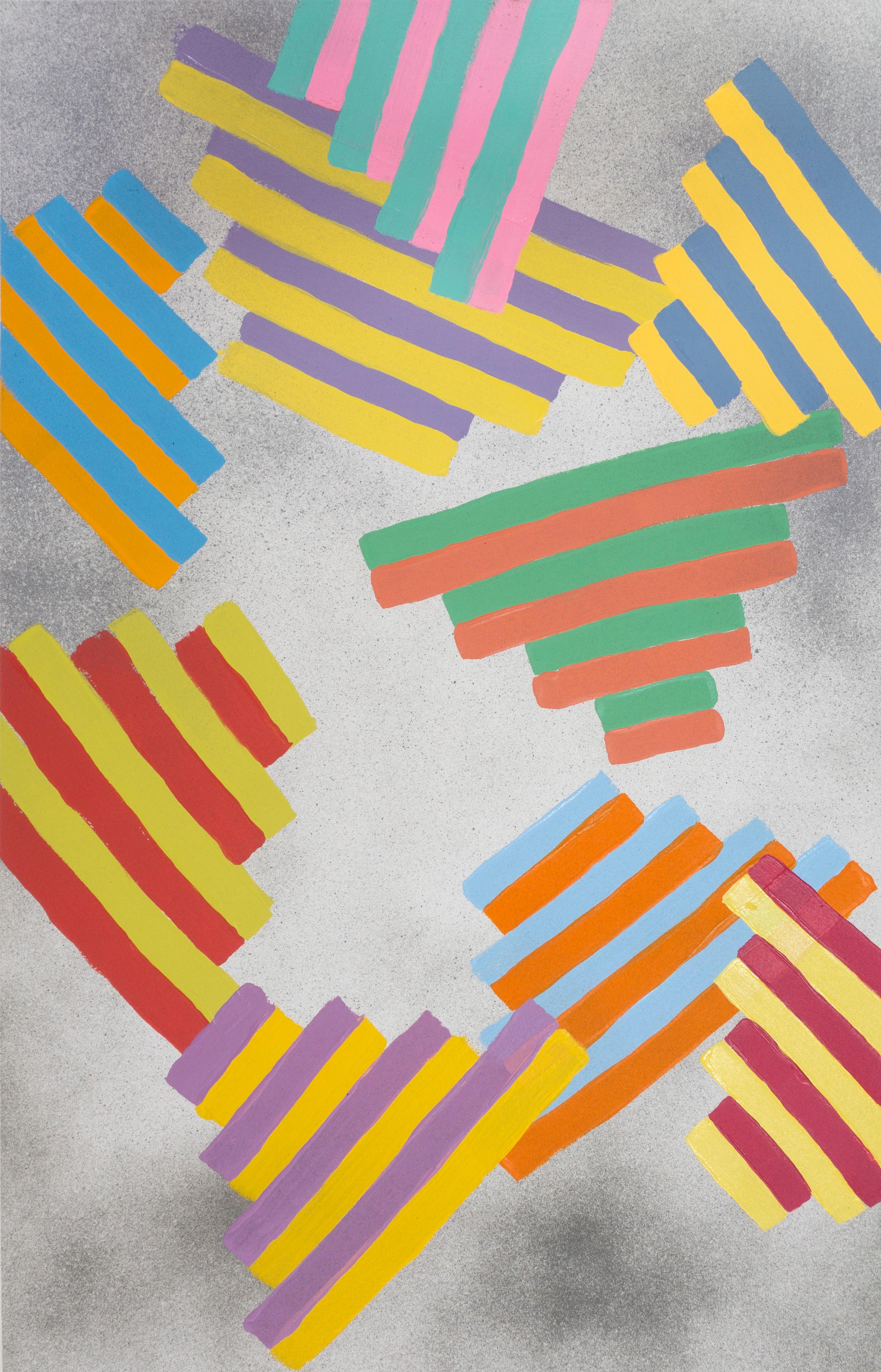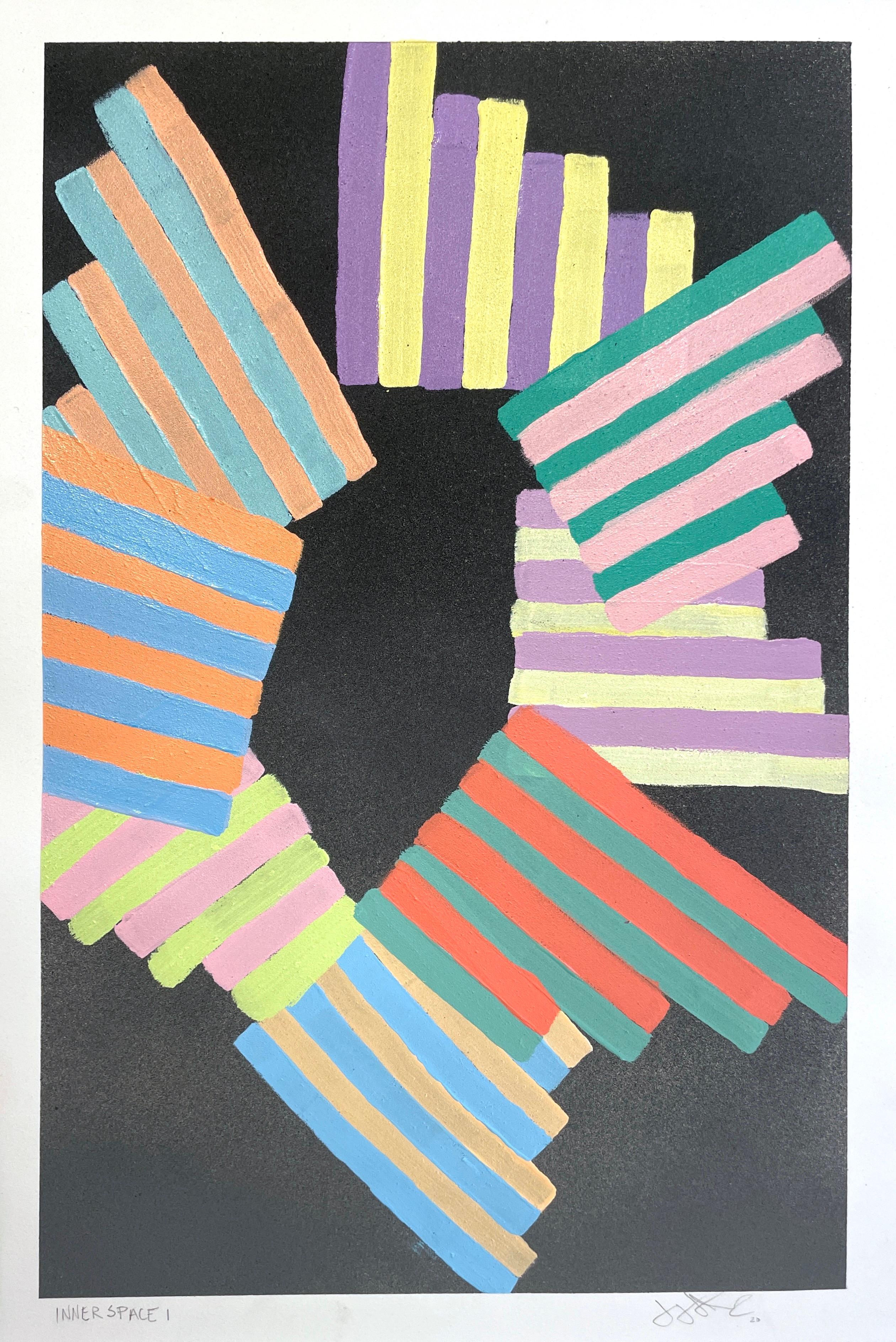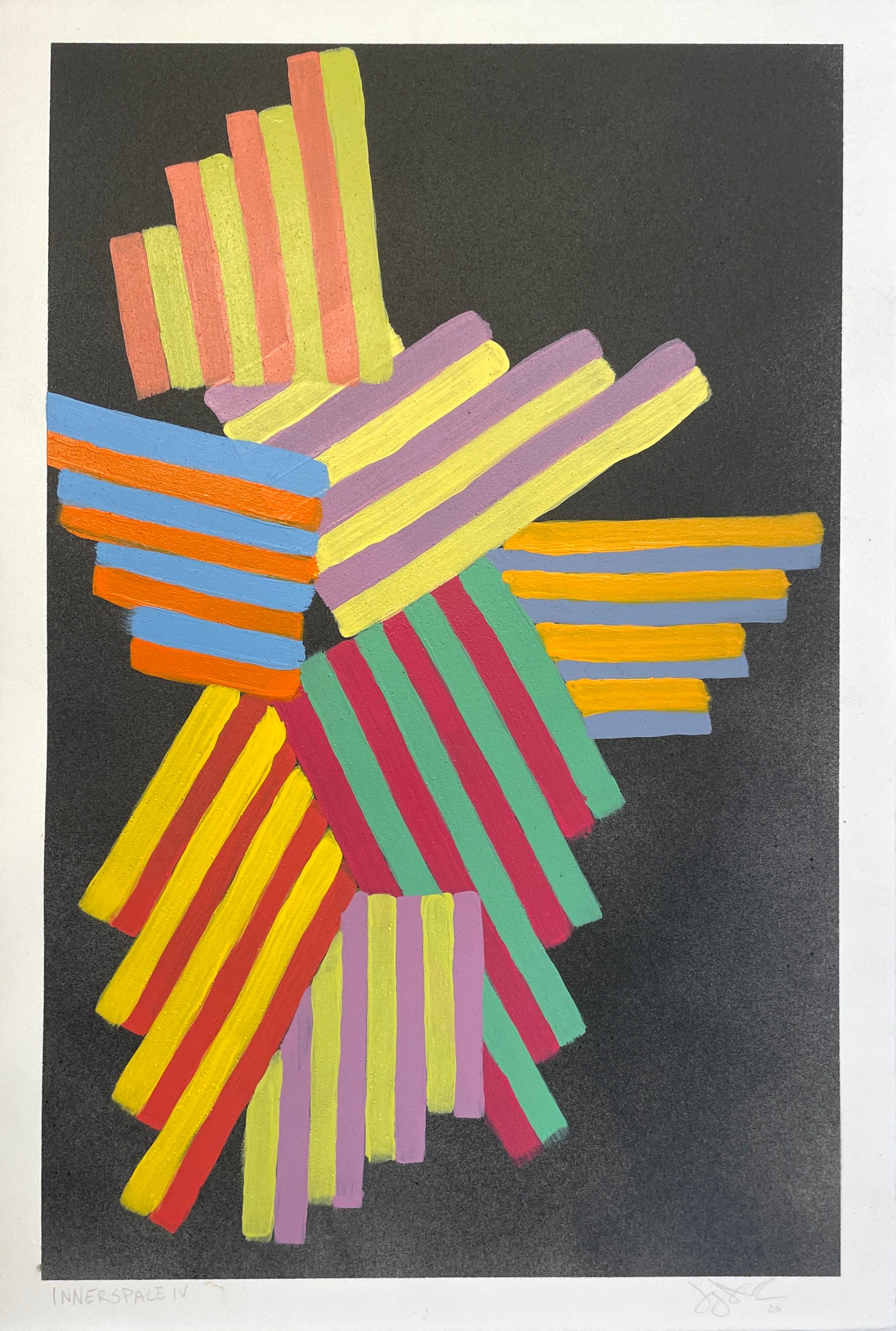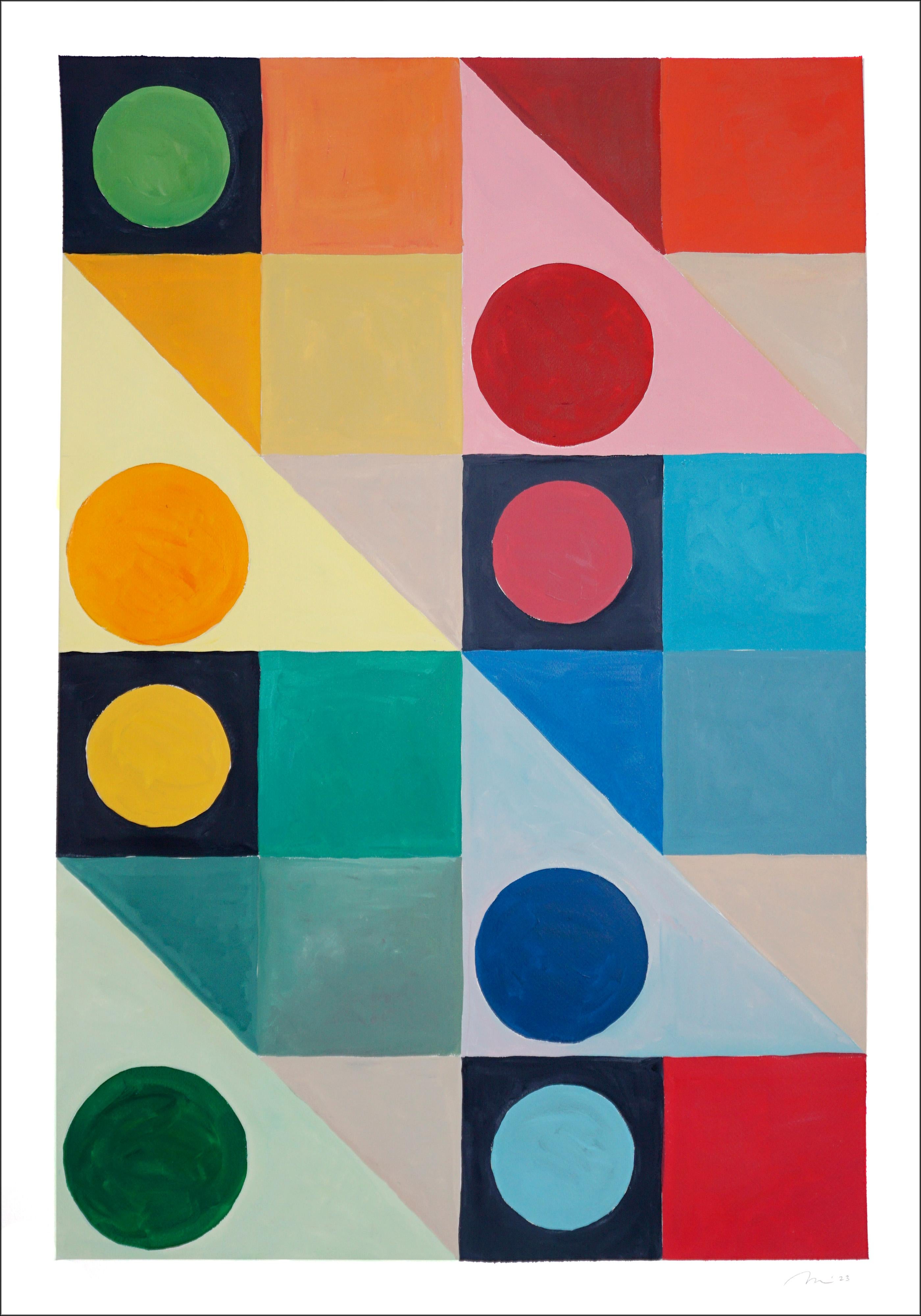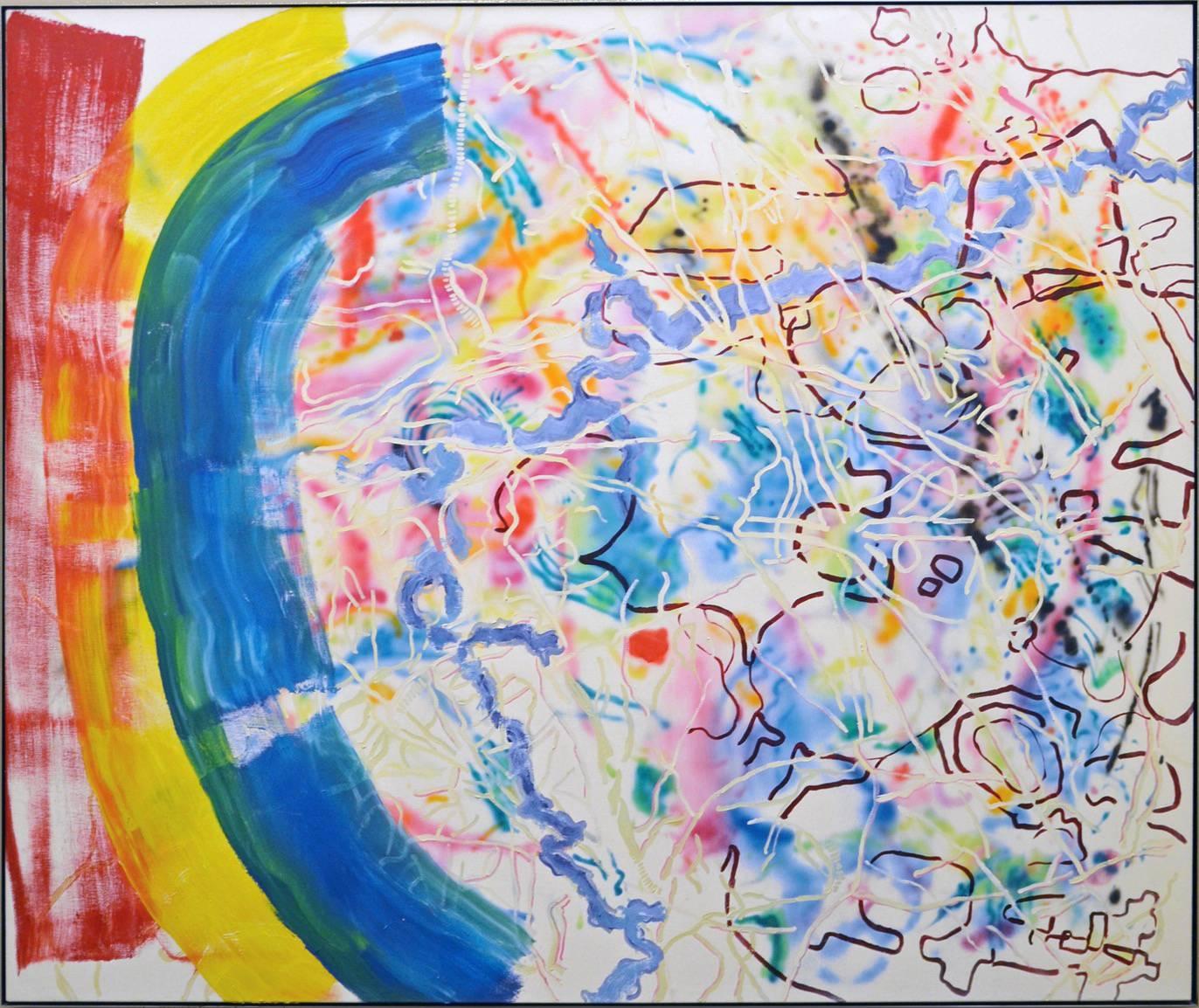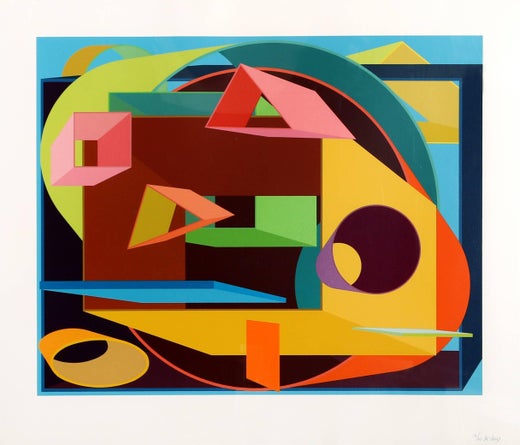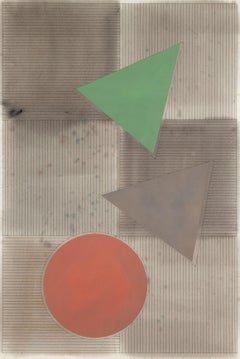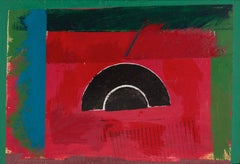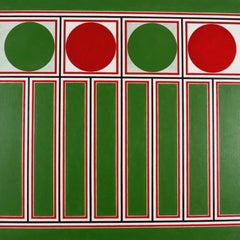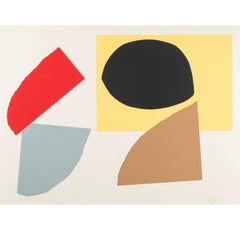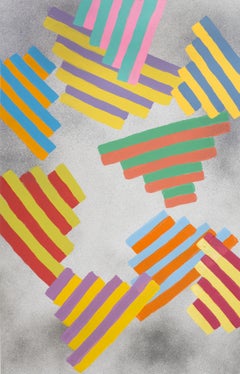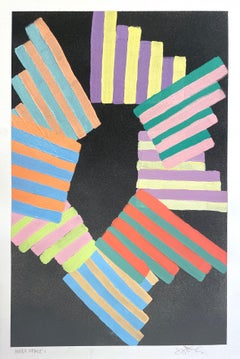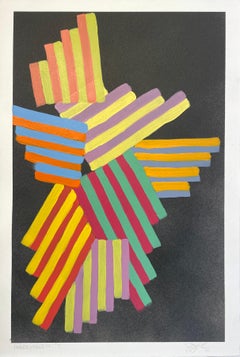Items Similar to Untitled - 20th Century Brightly Colored Print, Yellow, Red, Green + Grey Circle
Want more images or videos?
Request additional images or videos from the seller
1 of 10
Al HeldUntitled - 20th Century Brightly Colored Print, Yellow, Red, Green + Grey Circle1968
1968
$3,353.71
£2,500
€2,899.31
CA$4,691.25
A$5,120.09
CHF 2,689.20
MX$62,185.83
NOK 33,744.36
SEK 31,668.14
DKK 21,650.54
About the Item
Born in Brooklyn in 1928 to Polish immigrants, Al Held claims to have been expelled from high school in the Bronx in 1944. After serving in the U.S. Navy from 1945 to 1947, Held associated with members of the activist group Folksay who viewed art as a forceful medium for political and social protest. Held had also cultivated an interest in visual art, primarily through film, and enrolled in classes at the Arts Students League in 1948 on a stipend from the G.I. Bill.
Held’s radical convictions were nurtured by his father’s Marxist beliefs and regular household political discussions. His earliest work was entirely figurative and shows the influence of Social Realism. Held had planned to study in Mexico with the renowned muralist David Alfaro Siqueiros, whose works’ monumental scale and expressive political content inspired him, but was unable to attend after the school lost its G.I. accreditation. Held opted to study instead at the Académie de la grande chaumière in Paris. Before leaving for France, Held was impressed by Jackson Pollock’s paintings in New York, but it was not until he arrived in Paris that he completely abandoned figuration.
In Paris Held took classes with the sculptor Ossip Zadkine at the academy and became part of the American expatriate circle that included artists Sam Francis, Ellsworth Kelly, Joan Mitchell, Haywood “Bill” Rivers, and George Sugarman, among others. Held received his first solo exhibition of small abstract works in Paris at the artist-run Galerie Huit in 1952. On his return to New York, Held quickly entered the orbit of Abstract Expressionist painters, particularly Franz Kline and Mark Rothko who mentored the younger Held. His post-Paris paintings of the 1950s were heavily impastoed, tactile canvases that retain the expressive gesture of Abstract Expressionism. He received his first New York solo exhibition at the Poindexter Gallery in 1959.
Held is considered a prominent figure among second-generation Abstract Expressionists, but his persistent exploration of illusionistic potential within abstraction and theoretical attitudes consistently defied many of the labels of post–Abstract Expressionist movements. In the early 1960s, Held’s paintings moved toward a growing sense of overall clarity and concreteness. Because of their sharpened contours, increasingly geometric forms, and gradually enlarged scale, he was associated with practitioners of Hard-edge painting such as Kelly and Frank Stella. However, Held remained distinct for his bold rejection of critic Clement Greenberg’s modernist doctrine, particularly its insistence on flatness. In 1967, Held became tired of the reductive geometric quality and flatness of his work and strove to incorporate space and volume into his canvases. His paintings of 1967–68 were exclusively black and white; after this point he began to explore the three dimensionality of the canvas by punching holes in it and structuring his compositions using vanishing points. After 1978, he began to experiment with vibrant colors in his illusionistic geometric compositions. Despite the shifts in Held’s evolving logic to reconcile ordered abstraction and illusionism, the dimensions of his canvases remained a constant throughout his career. Held’s persistent drive for architectural scale also found expression in several noteworthy murals, the first of which, I and We (1967), was commissioned for Walter Gropius’s Tower East in Cleveland. In 2005 Held completed a mural for the New York City Subway system; he died later that year at his home in Todi, Italy.
Held was an associate professor of art, Yale University, New Haven, from 1962 to 1980. He received numerous awards and grants, including the Frank G. Logan Medal from the Art Institute of Chicago (1964), John Simon Guggenheim Memorial Foundation Fellowship in painting (1966), and a six-month residency at the American Academy in Rome (1981). In 1984 Held was elected to the American Academy of Arts and Letters.
Although Held’s committed search for an alternative to the reductivist logic that evolved out of Abstract Expressionism did not gain him immediate acceptance in the 1950s art world, his work was presented in many significant group exhibitions in the 1960s at the Guggenheim Museum (1961, 1966); Jewish Museum, New York (1963); Los Angeles County Museum of Art (1964); Museum of Modern Art, New York (1964); and Documenta, Kassel, West Germany (1968), among other venues. Notable solo exhibitions include those at the Stedelijk Museum, Amsterdam (1966); traveling exhibitions at the San Francisco Museum of Art (now San Francisco Museum of Modern Art) and the Corcoran Gallery of Art, Washington, D.C. (1968) as well as at the Institute of Contemporary Art, Philadelphia, and Contemporary Arts Museum, Houston (1968); Whitney Museum of American Art, New York (1974); Institute of Contemporary Art, Boston (1978); FIAC Foire internationale d’art contemporain, Grand Palais, Paris, with André Emmerich Gallery (1981); and P.S. 1 Contemporary Art Center (now MoMA PS1), New York (2002).
- Creator:Al Held (1928 - 2005, American)
- Creation Year:1968
- Dimensions:Height: 38.59 in (98 cm)Width: 26.38 in (67 cm)
- Medium:
- Movement & Style:
- Period:
- Condition:
- Gallery Location:Kingsclere, GB
- Reference Number:1stDibs: LU2718216449622
Al Held
Alvin Jacob Held, (1928-2005) Al Held earned his slot in the annals of American contemporary art with his bold, geometric canvases that took abstraction to another level. His free-floating, interlocked cubes, and planes invited the viewer into a vertigo-inducing landscape that seemed to stretch on into infinity. "Immense architectural structures curve and slice through these complex paintings, often enmeshing themselves in cellular structures," noted the Times of London. "Viewers felt that they were exploring some mysterious universe, and Held never lost his passionate belief in abstract painting's ability to create a sublime new world."
Held grew up in Brooklyn, New York, and as a teenager, missed so many days of high school that it was suggested he consider leaving altogether. He eventually earned a night-school diploma, and spent two years in the U.S. Navy. Back in New York City, he enrolled in classes at the Art Students League, and went on to study at the Académie de la Grande Chaumière in Paris in the early 1950s. The first solo exhibition of his work was staged there, in 1952 at the Galerie Huit. Held's abstract work took on a more orderly, formal tone, aided by a switch from oil to acrylic paints in 1959, and he had his first solo show in New York City that same year at the Poindexter Gallery. "Finessing the gap between Minimalism and Color Field painting," wrote New York Times journalist Ken Johnson of the next decade of Held's career, "he produced smooth, simplified works based on enlarged letters of the alphabet. And in the late '60s and '70s he made complex black-and-white pictures of sharply outlined cubes, pyramids, and other geometric shapes floating in illusory spaces of indeterminate depth."
Some of Held's best-known works are those floating black and white cubes, a series he began in 1967. One of the largest, which stretches more than 90 feet in length, was installed at the Empire State Plaza in Albany, New York. In the late 1970s, in an abrupt shift, he began using color again, and the geometric shapes became so precise that they were sometimes mistaken for computer-generated art. Held considered his images not unlike those of religious art, once telling an interviewer that "historically, the priests and wise men believed that it was the artist's job to make images of heaven and hell believable, even though nobody had experienced these places," he said, according to his Chicago Tribune obituary.
Held spent 20 years teaching at Yale University's. Represented by the Robert Miller Gallery in New York City, which staged what would be his last exhibition of new work in 2003, Held's works were avidly sought by contemporary-art enthusiasts around the world, and were part of the permanent collections of many institutions, including the Metropolitan Museum of Art and the Museum of Modern Art. — Carol Brennan
About the Seller
No Reviews Yet
Vetted Professional Seller
Every seller passes strict standards for authenticity and reliability
Established in 2010
1stDibs seller since 2024
43 sales on 1stDibs
Typical response time: 8 hours
- ShippingRetrieving quote...Shipping from: Kingsclere, United Kingdom
- Return Policy
Authenticity Guarantee
In the unlikely event there’s an issue with an item’s authenticity, contact us within 1 year for a full refund. DetailsMoney-Back Guarantee
If your item is not as described, is damaged in transit, or does not arrive, contact us within 7 days for a full refund. Details24-Hour Cancellation
You have a 24-hour grace period in which to reconsider your purchase, with no questions asked.Vetted Professional Sellers
Our world-class sellers must adhere to strict standards for service and quality, maintaining the integrity of our listings.Price-Match Guarantee
If you find that a seller listed the same item for a lower price elsewhere, we’ll match it.Trusted Global Delivery
Our best-in-class carrier network provides specialized shipping options worldwide, including custom delivery.More From This Seller
View AllRed/Green, from Study for Larger Tri Motif Series, 1977 - Gouache, Watercolour
By Gordon House
Located in Kingsclere, GB
Gordon House was born in 1932 in Pontardawe, South Wales. Early exposure to art on trips to the Glynn Vivian Art Gallery as a young boy inspired House towards creative endeavors and at the age of fourteen he was awarded a grant to enter art school which he accepted. From 1947 to 1950 he studied at Luton School of Art, Bedfordshire, and St. Albans School of Art, Hertfordshire. House's contemporaries included Richard Smith and John Plumb with whom he remained close. During the early fifties, after finishing art school, House began work as assistant to the ecclesiastical sculptor Theodore Kern. He also spent time at an advertising studio where he honed his burgeoning skills in typography and graphic design. In 1952 House was offered the position of designer for Imperial Chemical Industries Plastics Division where he stayed until 1959. This was followed by two years spent as graphic designer for the Kynoch Press in London. In 1961 House set out on his own as a self-employed designer and typographer. Initially this was supplemented by part-time teaching at art schools in and around London but by 1964 House was able to devote himself entirely to his design work which freed up valuable time to concentrate on his own artistic output in the studio.
In the late fifties, informed by the new art emerging from America and that of his contemporaries in England, House began to create large-scale abstract works which he was invited to show in 1959 at Dennis Bowen's legendary New Vision Centre in Marble Arch.
House was an active participant in the vibrant London art scene of the sixties, regularly attending lectures, exhibitions and discussions. In 1960 he exhibited in 'Situation' the key abstract exhibition of the decade held at the RBA Galleries. Other participating artists included Robyn Denny, Bernard and Harold Cohen, Gillian Ayres, John Hoyland, Richard Smith and William Turnbull among others. These artists, united by a common admiration for American Abstract Expressionism, were frustrated by the lack of exposure given to large-scale abstract works in commercial galleries so they organised their own exhibition. The name was derived from the participants' idea that an abstract painting that occupied the whole field of vision would involve the spectator in an 'event' or 'situation'. This exhibition was followed by 'New London Situation' in 1961 and a nationwide touring Arts Council presentation in recognition of the significance of the two earlier shows.
In 1961 House began producing his first prints at the Kelpra Studio, run by Chris and Rose Prater, where he made the earliest fine art screenprint ever to be produced in Britain. Artists such as Paolozzi and Hamilton followed in his footsteps and together they started a printmaking revolution in Britain. They cemented the medium of the screenprint in the world of fine art as opposed to the commercial sphere and secured the reputation of Kelpra in the process. Later, together with Cliff White, House set up the White Ink (Ltd.) print studio in London, where he produced etchings and wood engravings on a series of magnificent antique printing presses...
Category
20th Century Abstract Paintings
Materials
Ink, Watercolor, Gouache
Inner and Outer Arc, 1970 - Geometric Abstract Painting
By Gordon House
Located in Kingsclere, GB
Gordon House was born in 1932 in Pontardawe, South Wales. Early exposure to art on trips to the Glynn Vivian Art Gallery as a young boy inspired House towards creative endeavors and ...
Category
1970s Abstract Paintings
Materials
Oil, Board
Red/Green Ornament Frieze I - Bold Green and Red Shapes, Abstract Oil Painting
By Gordon House
Located in Kingsclere, GB
Gordon House 1932-2004
Red/Green Ornament Frieze I, 1976-1977
signed and dated on the canvas overlap
acrylic on canvas
91 x 91 cm
35 7/8 x 35 7/8 in
Gordon House was born in 1932 in Pontardawe, South Wales. Early exposure to art on trips to the Glynn Vivian Art Gallery as a young boy inspired House towards creative endeavors and at the age of fourteen he was awarded a grant to enter art school which he accepted. From 1947 to 1950 he studied at Luton School of Art, Bedfordshire, and St. Albans School of Art, Hertfordshire. House's contemporaries included Richard Smith and John Plumb with whom he remained close. During the early fifties, after finishing art school, House began work as assistant to the ecclesiastical sculptor Theodore Kern. He also spent time at an advertising studio where he honed his burgeoning skills in typography and graphic design. In 1952 House was offered the position of designer for Imperial Chemical Industries Plastics Division where he stayed until 1959. This was followed by two years spent as graphic designer for the Kynoch Press in London. In 1961 House set out on his own as a self-employed designer and typographer. Initially this was supplemented by part-time teaching at art schools in and around London but by 1964 House was able to devote himself entirely to his design work which freed up valuable time to concentrate on his own artistic output in the studio.
In the late fifties, informed by the new art emerging from America and that of his contemporaries in England, House began to create large-scale abstract works which he was invited to show in 1959 at Dennis Bowen's legendary New Vision Centre in Marble Arch.
House was an active participant in the vibrant London art scene of the sixties, regularly attending lectures, exhibitions and discussions. In 1960 he exhibited in 'Situation' the key abstract exhibition of the decade held at the RBA Galleries. Other participating artists included Robyn Denny, Bernard and Harold Cohen, Gillian Ayres, John Hoyland, Richard Smith and William Turnbull among others. These artists, united by a common admiration for American Abstract Expressionism, were frustrated by the lack of exposure given to large-scale abstract works in commercial galleries so they organised their own exhibition. The name was derived from the participants' idea that an abstract painting that occupied the whole field of vision would involve the spectator in an 'event' or 'situation'. This exhibition was followed by 'New London Situation' in 1961 and a nationwide touring Arts Council presentation in recognition of the significance of the two earlier shows.
In 1961 House began producing his first prints at the Kelpra Studio, run by Chris and Rose Prater, where he made the earliest fine art screenprint ever to be produced in Britain. Artists such as Paolozzi and Hamilton followed in his footsteps and together they started a printmaking revolution in Britain. They cemented the medium of the screenprint in the world of fine art as opposed to the commercial sphere and secured the reputation of Kelpra in the process. Later, together with Cliff White, House set up the White Ink (Ltd.) print studio in London, where he produced etchings and wood engravings on a series of magnificent antique printing...
Category
1970s Paintings
Materials
Canvas, Acrylic
Abstract Form by John Mclean, 1995
Located in Kingsclere, GB
Abstract Form by John Mclean, 1995
Additional information:
Medium: screenprint
56 x 75 cm
22 x 29 1/2 in
signed and dated in pencil
British abstract painter, born in Liverpool to S...
Category
20th Century Abstract Prints
Materials
Screen
Red Forms with Small Green Segment - Bold 1960s Abstract Oil Painting, Sixties
By Gordon House
Located in Kingsclere, GB
Gordon House was born in 1932 in Pontardawe, South Wales. Early exposure to art on trips to the Glynn Vivian Art Gallery as a young boy inspired House towards creative endeavors and at the age of fourteen he was awarded a grant to enter art school which he accepted. From 1947 to 1950 he studied at Luton School of Art, Bedfordshire, and St. Albans School of Art, Hertfordshire. House's contemporaries included Richard Smith and John Plumb with whom he remained close. During the early fifties, after finishing art school, House began work as assistant to the ecclesiastical sculptor Theodore Kern. He also spent time at an advertising studio where he honed his burgeoning skills in typography and graphic design. In 1952 House was offered the position of designer for Imperial Chemical Industries Plastics Division where he stayed until 1959. This was followed by two years spent as graphic designer for the Kynoch Press in London. In 1961 House set out on his own as a self-employed designer and typographer. Initially this was supplemented by part-time teaching at art schools in and around London but by 1964 House was able to devote himself entirely to his design work which freed up valuable time to concentrate on his own artistic output in the studio.
In the late fifties, informed by the new art emerging from America and that of his contemporaries in England, House began to create large-scale abstract works which he was invited to show in 1959 at Dennis Bowen's legendary New Vision Centre in Marble Arch.
House was an active participant in the vibrant London art scene of the sixties, regularly attending lectures, exhibitions and discussions. In 1960 he exhibited in 'Situation' the key abstract exhibition of the decade held at the RBA Galleries. Other participating artists included Robyn Denny, Bernard and Harold Cohen, Gillian Ayres, John Hoyland, Richard Smith and William Turnbull among others. These artists, united by a common admiration for American Abstract Expressionism, were frustrated by the lack of exposure given to large-scale abstract works in commercial galleries so they organised their own exhibition. The name was derived from the participants' idea that an abstract painting that occupied the whole field of vision would involve the spectator in an 'event' or 'situation'. This exhibition was followed by 'New London Situation' in 1961 and a nationwide touring Arts Council presentation in recognition of the significance of the two earlier shows.
In 1961 House began producing his first prints at the Kelpra Studio, run by Chris and Rose Prater, where he made the earliest fine art screenprint ever to be produced in Britain. Artists such as Paolozzi and Hamilton followed in his footsteps and together they started a printmaking revolution in Britain. They cemented the medium of the screenprint in the world of fine art as opposed to the commercial sphere and secured the reputation of Kelpra in the process. Later, together with Cliff White, House set up the White Ink (Ltd.) print studio in London, where he produced etchings and wood engravings on a series of magnificent antique printing presses...
Category
20th Century Abstract Paintings
Materials
Oil, Board
Florentine 2, Abstract Yellow and Orange Print on White with Mixed Media, 1973
By Richard Smith
Located in Kingsclere, GB
Florentine 2 by Richard Smith, 1973
Additional information:
Medium: lithograph on heavy wove paper, with carbon tracing paper and plastic strings
19 3/4 x 27 1/2 in
50 x 70 cm
signed, dated and numbered 46/75 in pencil
Charles Richard "Dick" Smith was an English printmaker and painter.
Smith was born in Letchworth, Hertfordshire, to Doris (née Chandler), a nurse and daughter of a chemical company director. He studied at Hitchin Grammar School and Luton School of Art. After military service with the Royal Air Force in Hong Kong, he attended St Albans School of Art followed by post-graduate studies at the Royal College of Art, London, from 1954-57. Smith shared a flat-cum-studio with Peter Blake in his second year at the RCA, and then again for two years after he left the college in 1957. When Terence Conran's Soup Kitchen opened on Fleet Street in the late 1950s, it featured a letter-collage mural by Smith and Blake. Michael Chow would later commission Smith to design installations for his restaurant in Los Angeles, and Chow and Conran have remained two of his biggest supporters.
In 1959 he moved to New York to teach on a Harkness Fellowship, staying for two years, where he produced paintings combining the formal qualities of many of the American abstract painters which made references to American commercial culture. The artist's first solo exhibition was at the Green Gallery. As his work matured it tended to be more minimal, often painted using one colour with a second only as an accent.
In trying to find ways of transposing ideas, Smith began to question the two-dimensional properties of art itself and to find ways by which a painting could express the shape of reality as he saw it. He began to take the canvas off the stretcher, letting it hang loose, or tied with knots, to suggest sails or kites - objects which could change with new directions rather than being held rigid against a wall, and taking painting close to the realm of sculpture. These principles he carried into his graphic work by introducing cut, folded and stapled elements into his prints; some works were multi-leaved screenprinting, and others printed onto three-dimensional fabricated metal.
Smith returned to England in 1963 - specifically East Tytherton, Wiltshire where Howard Hodgkin was a neighbour - and gained critical acclaim for extending the boundaries of painting into three dimensions, creating sculptural shaped canvases with monumental presence, which literally protruded into the space of the gallery. Evocative titles such as Panatella and Revlon, and cosmetic, synthetic colours alluded to the consumer landscapes of urban America which had proved so influential. He showed at the Kasmin Gallery, a venture between Kas and the Marquess of Dufferin and Ava in New Bond Street, throughout the 60s, more-widely known as David Hockney's first gallery.
After being awarded the Grand Prize at the 9th São Paulo Biennial in 1967 and important exhibitions at Kasmin in 1963, Tate in 1964, and Richard Feigen Gallery in 1966, Smith was invited to exhibit at the XXXV Venice Biennale as the official British artist in 1970. Smith was chosen by a committee of art experts, who were Director of Tate Norman Reid, art historian Alan Bowness, art collector David Thompson, the British Council’s Lilian Somerville and art historian Norbert Lynton. Smith taught with Richard Hamilton at Gateshead in 1965, where he met Mark Lancaster and Stephen Buckley, and again in 2000, becoming close to the artist and his wife, Terry.
By the late 1960s Smith's ambition to produce paintings which shared a common sensibility with other media, such as film and photography, began to wane and he focused on the formal qualities of painting. The freestanding installation Gazebo exhibited at the Architectural League of New York in 1966, and a tent project at the Aspen Design...
Category
20th Century Abstract Prints
Materials
Lithograph
You May Also Like
Colorful Geometric Silkscreen by Jean Dewasne
By Jean Dewasne 1
Located in Long Island City, NY
French painter, writer and sculptor. He began painting at the age of 12 and was producing pointillist works at the age of 18. He studied architecture for two years at the Ecole des Beaux-Arts in Paris as a preparation for his painting. In about 1943 he began painting abstract works, and he remained an abstract painter for the rest of his career. He was associated with the group of abstract artists who exhibited at the Galerie Denise René in Paris, including Hans Hartung, Nicolas de Stäel and Serge Poliakoff, and he himself exhibited there from 1945 to 1956. Together with Sonia Delaunay, Hans Arp, Antoine...
Category
1970s Abstract Geometric Abstract Prints
Materials
Screen
Inner Space #9: geometric abstract painting; yellow, red, blue, green & gray
By Jay Walker
Located in Bryn Mawr, PA
Jay Walker's latest series, "Inner Space," analyzes a single motif built from repeating parallel lines that is commonly found in his work. In this series of...
Category
2010s Abstract Abstract Paintings
Materials
Acrylic, Archival Paper
Inner Space #1: geometric abstract painting on paper: yellow, green, red, black
By Jay Walker
Located in Bryn Mawr, PA
Jay Walker's "Inner Space" series analyzes a single motif built from repeating parallel lines that is commonly found in his work. In this series of 12 paintings on paper, Walker expl...
Category
2010s Abstract Abstract Paintings
Materials
Acrylic, Archival Paper
Inner Space #4: geometric abstract painting on paper: yellow, green, red & black
By Jay Walker
Located in Bryn Mawr, PA
Jay Walker's "Inner Space" series analyzes a single motif built from repeating parallel lines that is commonly found in his work. In this series of 12 paintings on paper, Walker expl...
Category
2010s Abstract Abstract Paintings
Materials
Acrylic, Archival Paper
Primary Tones Geometric Rainbow, Vertical CMYK and Circles Squares, Red, Yellow
By Natalia Roman
Located in Barcelona, ES
These series of paintings by Natalia Roman gather their inspiration from geometric, minimalist shapes and paintings from the beginning of Modernism, with a special emphasis on Bauhau...
Category
2010s Op Art Abstract Paintings
Materials
Acrylic, Handmade Paper
"RBY" 1980 oil/canvas - Large Very colorful abstract yellow red blue green white
By Nancy Graves
Located in Rancho Santa Fe, CA
Signed, titled and dated verso 1980 (11–’80) "RBY"
oil on canvas
Provenance: Irving Galleries, Palm Beach, Florida 1985;
Private Collection, Palm Springs, CA
...
Category
1980s Abstract Abstract Paintings
Materials
Canvas, Oil
